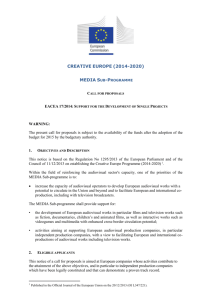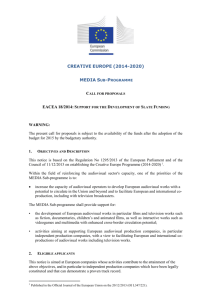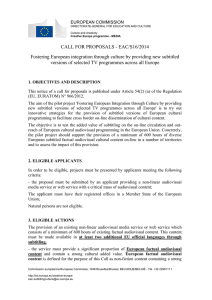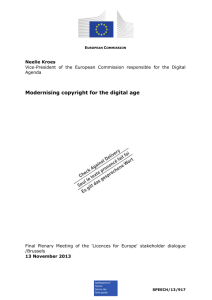Tax Incentives for Films and Audiovisual Works in France
advertisement
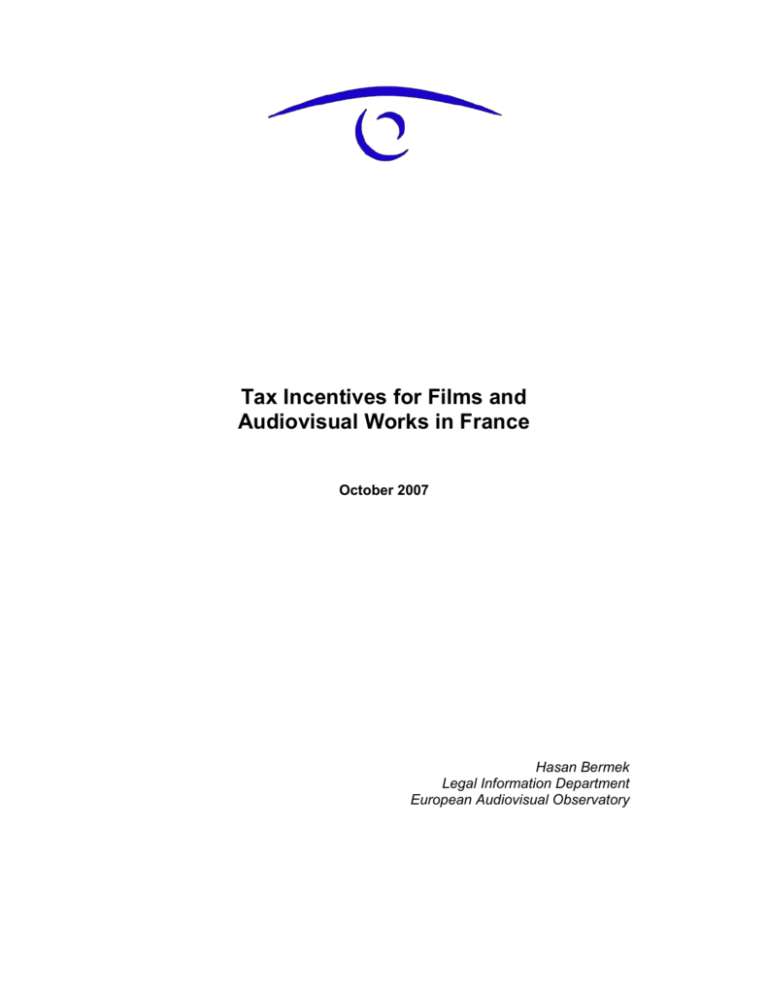
Tax Incentives for Films and Audiovisual Works in France October 2007 Hasan Bermek Legal Information Department European Audiovisual Observatory List of abbreviations: AMF CGI CNC CSA DGI IFCIC Autorité des Marchés Financiers Code général des impôts – French tax code Centre national de la Cinématographie – National Film Centre Conseil supérieur de l’audiovisuel Direction Générale des Impôts Institut pour le Financement du cinéma et des Industries Table of content I) The context of the French tax incentives.................................................. 5 A Direct State intervention:..................................................................... 6 B) Indirect intervention ............................................................................. 7 II. Characteristics of tax incentive schemes ................................................. 9 III Description of French tax incentives for films and audiovisual works....................................................................................................... 12 A) Measures aimed at professionals of the film and audiovisual sectors ............................................................................................... 12 1) 2) 3) 4) 5) Tax credits for the production of films and audiovisual works ......................................................................................... 12 Tax credit for distribution expenses of audiovisual programmes .............................................................................. 16 Exemption from Business Tax .................................................. 17 Amortisation and Depreciation.................................................. 18 Special VAT rules...................................................................... 19 B) Measures aimed at investors ............................................................ 19 1) 2) SOFICA ..................................................................................... 19 Investments in Overseas Departments and Territories ............ 22 3 4 The French State aid framework for the film and audiovisual industry is among the most comprehensive in Europe. It is also endowed with the highest financial resources in absolute terms. While direct aid distributed by the CNC (National Film Centre) and the French regions remains the most visible component of this scheme, this aid has been increasingly complemented with more indirect financial mechanisms, and notably by tax incentives. This is also reflected in the European Commission’s examination of the French support scheme for films and audiovisual works, which received the Commission’s global approval until 20111. It is useful, therefore, to assess the position of tax-based support schemes in the general context of State aid to the film and audiovisual industries in France (I). It is important to note that, despite their specificities, tax incentives share many features with more direct forms of aid (II). This general assessment will then be followed by a more in-depth description of the main tax support schemes in favour of the film and audiovisual sector, including legal and practical aspects (III). I) The context of the French tax incentives The cultural dimension of films and audiovisual works is the main political justification for the French state support system, which has always been one of the major components of French cultural policy. This is also confirmed by the fact that the CNC, created in 1946, operates under the supervision of the Ministry of Culture and Communication and that the ‘radiance’ (rayonnement) of French culture, and in particular of French cinema, is explicitly proclaimed as an aim of the French State. However, the French support scheme has often been described as being mainly economic and as an important tool of industrial policy2. The terms ‘film industry’ and ‘audiovisual industry’ regularly appear in the titles of regulatory texts that organise this funding. The will to promote France as a shooting location and to prevent relocations has also become more apparent over time, in particular through increasing aid provided to technical industries and R&D. Tax incentives have to be seen against the background of State aid provided to the film and audiovisual industry in general and as an important component of it. This aid may take several forms: It may involve a direct intervention of the State or regional authorities, via a selective redistribution of resources by public bodies (A). It may also entail the contribution of the private sector to the 1 Decision C(2006)832 Final of the Commission of 22 March 2006 (State Aid NN 84/2004 and N 95/2004 — France, aid schemes for the cinema and audiovisual industry) http://ec.europa.eu/comm/competition/state_aid/register/ii/doc/NN-84-2004-WLWL-fr22.03.2006.pdf 2 European Audiovisual Observatory, “Public funding for film and audiovisual works in Europe – a comparative approach”, Strasbourg, 2004, p. 30. 5 film and audiovisual industry. The State intervention for this second type of aid, which comprises tax incentives, mainly consists in obliging or encouraging economic actors to invest in the industry (B). A Direct State intervention: This method of public aid consists in the provision of direct funding by the French authorities to specific projects or companies. While funds distributed by the French National Film Centre (CNC) remain by far the most important component of this aid, the French regions and certain local authorities have also been playing an increasingly important role. Other bodies, such as the Ministry of Foreign affairs, also provide limited funding. CNC distributes a wide array of automatic and selective aids to the film and audiovisual industries, covering all stages of the value chain (development, production, distribution and marketing, exploitation), as well as aid to technical industries and research and development. The resources for this aid come from the financial support fund for the film and audiovisual industry (Compte de soutien financier de l'industrie cinématographique et de l'industrie audiovisuelle). The fund, administered by the CNC, was established in 1956. It was extended to audiovisual productions in 1986 and to video in 1993. The fund is mainly financed by taxes and levies affecting the audiovisual sector (i.e. tax on cinema admissions, tax on advertisement broadcasting, taxes on DVDs and videos)3. According to the figures provided by the French authorities to the Commission, the CNC distributed EUR 251.62m to the film industry and EUR 221.11m to the audiovisual industry in 2006. France also boasts the largest number of regional and local film funding bodies in Europe. Most of these funds operate at the level of regions, but certain departments, cities and towns also provide funding. In 2004, a new generation of tripartite conventions (State-CNC-Regions) was put in place, which involve a State contribution of one EUR for every two EUR awarded by the regions. Regional Directorates of Cultural Affairs (DRAC, Directions régionales des affaires culturelles), decentralised agencies of the Ministry of Culture also participate in regional funding schemes via specific projects. 3 As this study will focus on tax incentives in favour of the film and audiovisual sector in France, these taxes, as well as the license fee (redevance audiovisuelle), are excluded from its scope. 6 B) Indirect intervention The French authorities also seek to stimulate economic activity in the film and audiovisual sector indirectly, either by imposing obligations on or giving financial incentives to private actors. Tax-based incentives could be examined under this category, which also includes statutory investment obligations for broadcasters and loan guarantees. 1) Investment obligations: Television broadcasters in France have the obligation to invest a set part of their turnover in film and audiovisual productions. 3.2% of their turnover must be invested in European films (2.5% in French films) and 16% to 18% in audiovisual works of “French original expression” (d’expression originale française). For cinema channels, such as Canal+, the obligation to invest in films is much higher – Canal+ must use 20% of its resources for the acquisition of films (12% minimum for European films and 9% for French films). The respect of these obligations is supervised by the French broadcasting regulatory authority (CSA, Conseil supérieur de l’audiovisuel)4. 2) Loan guarantees: The French authorities also aim at encouraging banks to give loans to films and audiovisual works, by covering part of the production risks. For this purpose, the IFCIC5, a lending institution owned 49% by the French State, was established. The IFCIC guarantees loans given by private banks to film and audiovisual companies. According to figures provided by the French authorities to the European Commission, it covered risks for a total amount of EUR 117.1 million (films) and EUR 40.3 million euros (audiovisual works) in 2005. The IFCIC guarantees these loans thanks to its own resources, as well as money allocated by the CNC to a special fund (fonds de garantie cinema/audiovisuel) every year (EUR 4.9m in 2005). 3) Tax incentives: Tax incentives have been increasingly used in order to support the film and audiovisual industries. One can distinguish between two types of measures, depending on their immediate beneficiaries: a) Measures aimed at professionals of the film and audiovisual sectors (production companies, distributors, exhibitors): These incentives reduce the fiscal charges of these companies, thereby increasing their profitability, competitiveness and attractiveness, and include: - Tax credits for film and audiovisual productions (III.A.1); - Tax credit for distribution of audiovisual works (III.A.2); - partial or total exemption from business tax (III.A.3); - special fiscal rules applying to amortisation of films and audiovisual works and depreciation of technical equipment (III.A.4); - Special VAT rules (III.A.5). 4 For details concerning the specific obligations of individual broadcasters: http://www.csa.fr/infos/controle/television_quotas_production.php 5 Art. 3 of Decree no.99-130 of 24 February 1999 and the statute of IFCIC of 11 September 2002. 7 b) Measures aimed at investors: These measures seek to encourage companies and physical persons, regardless of their field of activity, to invest in the film and audiovisual industry, by reducing their corporation or income tax liability. They include: - SOFICAs (III.B.1); - Tax advantages for investments in French overseas departments and territories relating to the film and audiovisual sectors (III.B.2). While the weight of fiscal incentives within the general promotion scheme is very difficult to assess, the French authorities provided some estimates to the Commission with respect to two schemes assessed by the latter (and cleared as being compatible with the EC Treaty): - SOFICAs collected EUR 46m, EUR 41.4m of which they invested in 76 film productions and 20 audiovisual productions in 2005. - Tax deductions and refunds regarding tax credits for film and audiovisual productions were EUR 45m and EUR 42m respectively in 2005. The French authorities estimated that the total cost of this measure shall not exceed EUR 130.5m in a given year. One has to bear in mind, however, that the distinction between direct and indirect aid is not always clear-cut. Although direct aid is generally associated with a more direct involvement of State authorities concerning decisionmaking and distribution, this is not necessarily the case. For example, automatic aid mechanisms significantly reduce the scope of State discretion. Also, while certain regulations relating to indirect support, such as statutory investment obligations, apply to all private companies fulfilling certain conditions, they can have a very individualised effect in practice: Canal+ was the only cinema channel in France for a long period and as such was the only company subject to the obligation of making substantial investments in film production. Similarly, certain tax incentives, such as tax credits, are subject to rigorous selection criteria and are approved by the State authorities at different stages of the procedure. The difference between the two methods is also blurred in terms of the source of the aid. For instance, the subsidies distributed by the CNC, despite being channelled via the CSA, are ultimately derived from the industry itself. Conversely, the financial burden of the French tax incentives is ultimately borne by the French Treasury - by relieving certain taxpayers from their fiscal charges, the State forfeits part of its income. While this loss should in principle be compensated by the taxation of the future profits of these schemes’ beneficiaries, as well as additional fiscal revenues generated by increased economic activity in the relevant sectors, this is by no means guaranteed owing to the risks inherent to the film and audiovisual industry. 8 II. Characteristics of tax incentive schemes In terms of historical development, the SOFICA system introduced in 1985 was the first tax incentive for the film industry. A more direct measure, the tax credit for film production companies was first introduced in 2004 and extended to audiovisual productions in 2005. The perceived success of this measure encouraged the French authorities to set up a tax credit for the distribution of audiovisual programmes in 2006. Similar to direct aid distributed by the CNC and the regions, the French tax incentive schemes for the film and audiovisual industries intervene at all relevant levels of the value chain: - Preproduction financing and capital formation (SOFICAs, incentives for investments in overseas territories); Production (tax credits, reduction of business tax, special rules relating to amortisation and VAT); Distribution (tax credit for distribution, reduction of business tax); Exploitation (exemption of cinemas from business tax, reduced VAT rates). The various tax incentive schemes also mirror the direct aid schemes in terms of territorial focus – while most tax-based support is borne by the French Treasury, the reduction of business tax can be considered as a local aid, as this tax is collected by local authorities. Again similarly to direct aid, the CNC plays a significant role in the granting of many of these tax advantages, via direct approvals of specific projects or advice provided to the Ministry of Culture on the granting by the latter of such approvals. These include notably the approval of SOFICAs or the approval of investments (agrément d’investissement) necessary for the SOFICAs to invest in a film, or the temporary and final approvals necessary for the tax credits for film and audiovisual productions. However, unlike the more traditional forms of State aid in this field, tax incentives also imply the intervention of authorities of a primarily non-cultural nature. For example, the French market regulation authority (AMF) intervenes in connection with the approval of the financial structure of SOFICAs. Naturally, the French fiscal services (Direction générale des Impôts, DGI), under the Ministry of Finance, are ultimately responsible for the functioning of all these tax advantages. 9 Tax incentives share other common features with direct aid measures: - Common definitions: Legal texts regulating the tax incentives make reference to many concepts defined elsewhere, such as the French Intellectual Property Code, the Film Industry Code or specific decrees. These definitions include, for example, ‘film’, ‘audiviosual work’, ‘fiction’, ‘animation’, ‘documentary’, ‘auteur’, ‘executive producer’ (producteur délégué), ‘pornographic works’, ‘art house’ (art et essai), etc. - Common criteria: Many criteria that condition access to direct funding schemes in France are also applied to tax incentives. Notable examples of this are: o Language requirements: most tax incentives require the relevant films and audiovisual works to be in French or in a regional language of France, but make provision for certain exceptions, in particular regarding foreign co-productions; o Nationality: relevant for most tax incentives, nationality is determined according to general criteria, including special rules regarding co-productions. The film must in general be French or have the nationality of a member State of the EU; o Local spend: the territorialisation conditions used in tax incentives use common elements with other funding schemes. For example, with regard to production tax credits, the same point system is used to determine the extent of expenditures made in France as for direct funding provided by CNC. o Exceptions: as for direct funding, certain types of works, such as pornographic works or works inciting to violence, are not entitled to any tax advantages. - Common documents and procedures: The granting of tax advantages often depend on whether certain general documents have been obtained, such as certificates for films (visa d’exploitation) or investment approvals (agrément d’investissement). The procedures for tax incentives also share common features with direct funding procedures. For example, approvals needed for tax credits (agrément provisoire and agrément à titre définitif) are modelled on direct funding approvals (agréments d’investissement and agrément de production). It is also important to note that tax-based support schemes can be combined with other forms of support, with which they are considered to have a cumulative effect for the purposes of the calculation of the total aid intensity for a film or audiovisual work. This cumulative intensity may not exceed 50% of the budget of a work, a threshold derived from the EU rules concerning State aid. Indeed, tax-based support to the film and audiovisual industries is treated as State aid under EC law, in the same way as other forms of aid. The main provisions are Articles 87 (1) and 87 (3) d of the EC Treaty, the respect of which is ensured by the European Commission in accordance with the 10 principles defined in its relevant Communication6. Significantly, SOFICAs and tax credits for films and audiovisual works were examined and cleared along with other aid measures in the framework of the Commission’s examination of the French State aid scheme for the film and audiovisual sectors. The French authorities also specified that the new tax credit for the distribution of audiovisual programmes shall be subject to the limits defined in the Commission’s de minimis aid Regulation7. 6 Communication from the Commission to the Council, the European Parliament, the Economic and Social Committee and the Committee of the Regions on certain legal aspects relating to cinematographic and other audiovisual works, COM(2001)534 final, OJ C 043 of 16 February 2002. 7 Commission Regulation (EC) No 1998/2006 of 15 December 2006 on the application of Articles 87 and 88 of the Treaty to de minimis aid, OJ L 379 of 28 December 2006. 11 III Description of French tax incentives for films and audiovisual works A) Measures aimed at professionals of the film and audiovisual sectors 1) Tax credits for the production of films and audiovisual works Legal basis Articles 220 sexies and 220 F of the CGI and Articles 46 quarter-0 YL to YR of its Appendix III; Decrees no 2006-325 and 2006-317 of 20 March 2006 History/Introduction A tax credit for film production was introduced with the 2004 Finance Act. This scheme was modified and extended to audiovisual productions in 2005. Tax credits are increasingly being used as a support method within the French cultural promotion framework, as shown by the recent adoption of tax credits for video games8 and phonographic works (including expenditure relating to video clips)9. These refundable tax credits complement CNC’s direct support to the film and audiovisual industries, by reducing corporation tax owed by production companies of eligible films or audiovisual works. The total amount of eligible production costs determines the amount of the tax credit, subject to certain limits. The tax credits are set off against the corporation tax due for the accounting period concerned. Conditions a) Eligible companies These must be film and audiovisual production companies: - subject to corporation tax; - acting as executive production companies (entreprises de production déléguée)10 ; 8 Article 244 quater S of the CGI; introduced by Law nº 2007-309 of 5 March 2007 Art. 37 I, to enter into force on 1 January 2008. 9 Article 220 octies of the CGI. 10 According to Article 6, para. 5 of the Decree no 99-130 of 24 February 1999 (film) and Article 3.II of the Decree no 95-110 of 2 February 1995 (audiovisual), these are defined as production companies which take the initiative for a film and assume the financial, technical and artistic responsibility for its making. The number of companies having this quality cannot be more than two for a single work. 12 - complying with the applicable social legislation. They must notably not use temporary contracts in order to fill permanent positions, i.e. jobs not directly linked to the production of a specific work. b) Eligible works The eligible works are films and audiovisual works in the fiction, documentary and animation genres. They must: - be made entirely or mainly in French or in a regional language in use in France11; - be made mainly on French territory: This condition is considered fulfilled if the work obtains at least half the points of the point system used by CNC for the granting of financial support, depending on the genre (except for the points allocated to the language of shooting where relevant). - have obtained from the CNC a provisional approval (agrément à titre provisoire) and a final approval (agrément à titre définitif) for the tax credit. - contribute to the development and diversity of film and audiovisual creation in France and in Europe. The last condition is only satisfied if the ‘auteurs’12, performing artists and production staff of the works are French or nationals of an EC or EEA member State (or another eligible European State). In addition, audiovisual works need to fulfil a number of criteria relating to minimum length and minimum production costs as follows: o Fiction – 45 minutes, EUR 5 000/min (EUR 3 000/min for works for a young public); o Documentary – 24 minutes, EUR 2 333/min; o Animation – 24 minutes, EUR 3 000/min. The following types of works are excluded from the benefit of the scheme altogether: o pornographic films or films inciting to violence; o works which can be used for advertisement purposes; o news programmes, talk-shows, sports programmes; o works which have only ancillary elements of original creation. The selection of qualifying works is made by an expert committee within CNC. 11 Except for texts sung in the original language of the libretto and documentary films, whose subject justifies the use of a foreign language. Any post-synchronisation of such documentary films or animated works must however be in French or a regional language of France (Art. 2 of Decree no.2006-325). 12 Those who are responsible for the intellectual creation of the work. In accordance with in Article L. 113-7 of the French Intellectual Property Code, these are notably the author of the script, the adaptation or the dialogues, the composer of the original soundtrack and the director. 13 c) Eligible costs: These have been detailed under Articles 46 quater-0 YM to YO of the CGI, and globally fall under the following categories: - Remunerations paid to ‘auteurs’ and related social charges (since 2006); - Remunerations paid to lead and supporting actors (up to the minimum amounts fixed in relevant collective agreements) and related social charges (to the extent that they are obligatory) (since 2006); - Salaries paid by the production company to technical staff and production workers, as well as related obligatory social charges. For technicians and workers with permanent contracts, only the period during which they were actually working on the work concerned is taken into account. - For films and documentaries, shooting costs: o use of studios (including construction of sets); o special effects; o costumes, hair and make-up; o technical material for filming. For animations: o costs of specialised service providers for the preparation and manufacturing of animations; o use of necessary technical material. - Post-production costs, including visual effects: - Film stock (or other media) and laboratory expenses. Calculation of the tax credit The tax credit is equal to 20% of the abovementioned eligible costs. These costs may not exceed 80% of the total production budget (or of the French part in an international co-production). If there are two executive production companies working on the same project, the tax credit is distributed in proportion to their contribution to the costs (and not according to their shares in the co-production). The tax credit for a single work may not exceed: - for films, EUR 1 000 000. - for audiovisual works: o fiction or documentary: EUR 1 150 per minute produced and delivered. o animated works: EUR 1 200 per minute produced and delivered. Grants received from public bodies also enter into the calculations. Subsidies directly used to cover eligible production costs are deducted from total eligible costs. For subsidies granted to a work globally (such as the automatic and selective aid granted by the CNC), the deduction is proportional to the weight of the eligible costs within the total production budget13. 13 For example, if eligible costs are EUR 1.2m for a total production budget of EUR 2m, this ratio would be 60% (1.2m/2m). If the production company receives an automatic financial support of EUR 200 000 for the work concerned, EUR 120 000 (60% of EUR 200 000) has to 14 It is important to note that under general rules relating to subsidies, the combination of different public subsidies, including the tax credit, may not exceed 50% of the total production budget for a single work. This threshold is raised to 60% for difficult films (1st or 2nd film of the director) or low-budget works (a budget of less than EUR 1m). Use of the tax credit For each accounting period in which the executive production company incurs eligible expenses, the corresponding tax credit is deducted from the corporation tax payable by that company. If the tax credit exceeds the corporation tax due, the surplus is treated as a claim on the Treasury, payable to the production company. In such cases, a refund request must be made to the “comptable chargé du recouvrement de l’impôt sur les sociétés”. Control/Reimbursement Tax credits received by the executive production company may have to be reimbursed for two reasons: - failure to obtain CNC’s final approval for tax credit: This approval must be obtained within the eight months following: o for a film, its certification (date of delivery of the visa d’exploitation); o for an audiovisual work, its completion (date of acceptance by a TV channel). - failure to complete the work: the work has to be completed within the two years following the end of the last accounting period having given rise to a tax credit. Procedural aspects 1) Before photography commences, a letter requesting the benefit of the tax credit has to be sent to the Director General of the CNC. For co-productions, each production company must submit a separate request. This letter must specify the title of the work, the names of the ‘auteurs’ and the director and the provisional date for the beginning of photography. This letter must be accompanied by the contracts of the ‘auteurs’, an estimate (devis) of production costs, as well as a provisional financing plan. Only costs incurred after the reception of this request by the CNC are eligible for the tax credit. 2) A provisional approval (agrément à titre provisoire) is delivered by the CNC within the six months following the initial request, after the opinion of the committee of experts and the submission of justifying documents. be deducted from the eligible costs. The final tax credit would therefore be therefore EUR 216 000 (20% of EUR 1 080 000) instead of EUR 240 000 (20% of EUR 1.2m). 15 The provisional approval is only delivered after an Approval Commission (commission d’agrément) has examined the request for an investment approval (agrément d’investissement). 3) CNC sends the provisional approval to the executive production company (or companies). The latter must send a copy of this document to the “comptable chargé du recouvrement de l’impôt sur les sociétés”. 4) The production company receives a tax credit for all eligible costs incurred during the accounting periods following the delivery of the provisional approval. 5) A final approval by CNC must be requested and obtained within 8 months following, for films, the delivery of the visa d’exploitation and, for audiovisual works, the acceptance of the work by a TV channel. For a film, the delivery of the final approval takes place after the delivery of the agrément de production. 2) Tax credit for distribution expenses of audiovisual programmes Legal basis: Article 220 duodecies of the CGI History/Introduction This new tax credit was introduced by the amending Finance Act for 2006 of 30 December 2006. In order to avoid a new State aid notification, the text provides that the tax credit shall be subject to the limits stipulated in the Commission’s de minimis Regulation. The latest version of this Regulation (Commission Regulation (EC) no 1998/2006 on the application of Articles 87 and 88 of the Treaty to de minimis aid) thus effectively restricts this tax credit to a maximum of EUR 200 000 over a period of three consecutive accounting periods. Conditions a) Eligible companies In order to qualify for the tax credit, distribution companies have to be independent from broadcasters (éditeurs de services de television) and their activities relating to the marketing of audiovisual programmes or formats must have generated a turnover of at least EUR 85 000 in the preceding fiscal year. A minimum 80% and 60% of their distribution turnover has to be devoted to European and French works respectively. b) Eligible works The tax credit only applies to audiovisual works made entirely or principally in French or in a regional language of France. Pornographic works or 16 programmes inciting to violence, as well as works having only ancillary elements of original creation may not benefit from this tax credit. c) Eligible costs The eligible costs fall under the three following categories: 1) International marketing: - advance payments made for the financing of production expenses; - costs relating to restoration, creation of new master copies in high definition, dubbing, subtitling, copying, digitalising, reformatting or clearing of rights held by production companies which distribute their own programmes. 2) Artistic costs: remunerations paid to dubbing artists, to the extent that they correspond to the minimum amounts fixed in relevant collective agreements, and related social charges, to the extent that they are obligatory. 3) Modernisation of tools and employment qualifications Technical materials and software for creating online catalogues; IT investments for the administrative and accounting follow-up of sales and rights management; Professional training for marketing and exporting audiovisual programmes. Calculation The tax credit is capped at 80% of the total distribution budget of the work concerned. It is equal to 20% of eligible distribution costs incurred in France during an accounting period ending in 2007 or 2008, provided that no promotion subsidy or another tax credit has been used to cover these costs. This tax credit being relatively recent, the Ministry of Finance has not yet issued an official bulletin defining in detail the use that can be made of this tax credit, its control and reimbursement, as well as the relevant procedures. 3) Exemption from Business Tax Business tax (taxe professionnelle) is a local tax, paid by companies and selfemployed persons. Its rates are determined by the local authority concerned, within the limits set by the central state. Business tax is subject to a ceiling, which is calculated in proportion to the added value produced by the company concerned in a given year (currently 3.5%, Art. 1647 B sexies of the CGI). As far as the film and audiovisual industries are concerned, special rules apply to producers, distributors and cinemas. 17 Producers: Under French fiscal rules, the production of a film is normally considered a self-constructed asset (production immobilisée) and thus constitutes an added value. However, for the purposes of the calculation of business tax, the authorities allow for these intangible assets to be deducted from the total added value produced by a production company, in so far as these assets also qualify for the special amortisation rules detailed below (see 4). Distributors: As of 2004, and subject to certain conditions, distributors are allowed to deduct from their added value all minimum guarantees paid to producers14. Cinemas; Article 1464 A of the CGI authorises local authorities to exempt, partially or totally, cinemas from business tax. The upper limits of this exemption are: - 100% for cinemas which have less than 5 000 admissions per week and which have been classified, for the purposes of the year of reference, as arthouse (art et essai)15. - 66% for cinemas, located in municipalities (commune) with less than 100 000 inhabitants, which have less than 2 000 admissions per week. - 33% for all other cinemas located in municipalities with less than 100 000 inhabitants. These exemptions are subject to a decision by the local authority to this effect and apply regardless of the number of screens of the cinemas concerned. 4) Amortisation and Depreciation Amortisation of films and audiovisual works: Films and audiovisual works are self-constructed intangible assets (production immobilisée). Producers of films and audiovisual works or distributors who hold their exploitation rights, are allowed to amortise these works under a special regime, independently of their useful life. The depreciation of films and audiovisual works take place over one year and the following coefficients apply to each month after completion16: Month Depreciation rate 1 30% 2 25% 3 20% 4 15% 5-6 2% 7-12 1% At the end of an accounting period, producers and distributors may allocate all net receipts17 of a specific work to its amortisation (i.e. deduct them from their revenues), within the depreciation limits detailed above. If at the end of an 14 Bulletin Officiel des Impôts, 6-E-11-05 no 174 of 21 October 2005. Decree no.2002-568 of 22 April 2002 regulates the definition and classification of arthouse cinemas. 16 Delivery of visa d’exploitation (films) or attestation d’acceptation (audiovisual products). 17 Net receipts are defined as gross box office receipts minus distribution expenses and a part of general exploitation costs (in proportion to gross receipts of other films being exploited). 15 18 accounting year, the net receipts of a work are lower than the total depreciation allowed, the remaining part can be amortised with receipts of other works in respect of which the depreciation limits have been exceeded. Treatment of technical subsidies to the film sector Article 39 sexies of the CGI provides that financial aid provided to cinemas and to technical industries, for the equipment and modernisation of studios and laboratories, is considered as taxable profit for the companies concerned. However, subsidies which have been used to finance fixed assets (considered as depreciable property (immobilisation amortissable) from a fiscal point of view) are allocated to the exceptional depreciation of the assets concerned. 5) Special VAT rules In France, the reduced VAT rate of 5.5% applies to: - cinema admissions (Art. 279 b quinquies of the CGI); - transfer of film rights (Art. 279 g). From a fiscal point of view, a cinematographic work fixed on a physical medium is considered as a capital expenditure. It should therefore normally be subject to VAT at its cost price, as a self-delivery of the producer, (Art. 257, para. 8 of the CGI). Nevertheless, the French fiscal authorities allow for VAT not to be applied to this operation, but only to receipts from the licensing and transfer of rights relating to the film concerned. B) Measures aimed at investors 1) SOFICA Legal basis Articles 199 unvicies, 217 septies, 238 bis HE to HM of the CGI, and Articles 46 quindecies A to F of its Appendix III; Decree no 95-544 of 2 May 1995. History/Introduction Introduced in 1985, SOFICAs (Sociétés pour le Financement du Cinéma et de l’Audiovisuel, Companies for the financing of films and audiovisual works) are public limited companies subject to corporation tax. They act as investment funds whose sole activity is the financing of films and audiovisual works. When a certain number of conditions are met (1), an investment in the shares of these companies entitles physical and legal persons to certain tax benefits (2). 19 SOFICAs have a statutory lifetime of 10 years. At the end of this period, they are liquidated and their net assets are distributed to their shareholders in proportion to their stakes in the SOFICA. Conditions The tax benefits are subject to a certain number of conditions, relating to the capital structure and activity of the SOFICA concerned (a), as well as to the selection of works they finance (b) and the form this financing takes (c). a) Conditions relating to the capital structure and activities of SOFICAs: The initial capital of SOFICAs, as well as any subsequent increase of their capital, must be pre-approved18 before any subscription for shares takes place. For a period of five years following the first subscription, either for the initial capital or any increase, no one person may hold, directly or indirectly19, more than 25% of a SOFICA’s shares. All subscriptions have to be made in cash. In accordance with Article 238 bis HE of the CGI, a SOFICA’s sole activity is the financing of cinematographic and audiovisual works. Nevertheless, the law allows SOFICAs to invest up to 10% of their share capital in interest-bearing accounts, provided that the funds remain liquid. Failure to comply with this condition results in fines for the SOFICA20 and a reappraisal of the tax benefits consented to its shareholders. b) Conditions relating to the works financed21 These works must: - be made in French; - have the nationality of a member State of the European Community; - have been accredited by the Director General of the CNC22. Nevertheless, up to 20% of the SOFICA’s funds may be used to finance coproductions in a foreign language, provided that it is the language of an EC member State where the majority co-producer is established. Certain types of audiovisual works are excluded from the scope of the SOFICA regime altogether23. 18 Agrément (approval) delivered by the Direction général des impôts, according to Article 1649 nonies of the CGI, following opinions of the CNC and the AMF (autorité des marchés financiers). 19 This includes holding via an intermediary or a community of interests. For example, if a physical person holds 80% of the shares of a company which holds 20% of the shares of a SOFICA, that physical person is considered to hold 16% of the SOFICA. 20 A fine equal to 25% of the capital used inappropriately. 21 Article 238 bis HF of the CGI 22 The conditions for the delivery of this accreditation have been laid down by the Decree no 95-544 of 2 May 1995. In particular, the accreditation is considered to be given if the work obtained from the CNC an “agrément d’investissement” (Art. 2, films) or an “autorisation préalable” (Art. 3, other audiovisual works). 23 Notably, pornographic works, works inciting to violence, works which could be used for publicity purposes, news programmes, talk shows, sports and entertainment programmes, works whose creative component is only ancillary. 20 In addition, the appendices to the decisions of approval of individual SOFICAs specify that 35% of their funds should be used to finance independent productions24. c) Conditions relating to the form of financing: The applicable law provides for two alternatives: 1) Acquisition of shares of production companies: These must be companies, subject to corporation tax, whose sole activity is the production of cinematographic or audiovisual works (This form of financing remains marginal). 2) Cash payments made under a partnership contract: These contracts entitle SOFICAs to a part of the financed work’s box office receipts. The payments must be made before the start of photography and may not exceed 50% of the work’s total budget. Such contracts do not confer on SOFICAs any exploitation rights per se or entitle them to public support for cinematographic or audiovisual works. Fiscal advantages for subscribers In order to benefit from the following advantages, the physical or legal persons concerned must keep their shares of SOFICAs for at least five years following their acquisition. Effects concerning Corporation Tax: The fiscal advantage for companies investing in SOFICAs takes the form of an exceptional amortisation (amortissement exceptionnel). In accordance with Article 217 septies of the CGI, companies subject to corporation tax can write off 50% of cash payments made for SOFICA shares against taxable profits. Effects concerning Income Tax: Physical persons or other persons25 subject to income tax investing in SOFICAs are also eligible for certain tax advantages, which have been significantly modified in December 200626. Whereas under the old system investments in SOFICAs were set off against taxable income, the new Article 199 unvicies of the CGI introduces a direct tax relief (réduction d’impôt) for subscriptions made between 1 January 2006 and 31 December 2008. This entails a reduction of income tax due, without the recalculation of taxable income. The reduction is equal to 40% of cash payments made for shares of a SOFICA (capped at 25% of total net income and EUR 18 000). This allows for a tax relief of up to EUR 7 200, for a net income higher than EUR 72 000. If the SOFICA concerned undertakes to use 10% of its capital to acquire shares 24 Report by Jean-Pierre Leclerc, commissioned by the French Ministry of Culture and Communication, « Réflexions sur le dispositif français de soutien à la production cinématographique », January 2003, p. 92. http://www.culture.gouv.fr/culture/actualites/rapports/leclerc/rapportleclerc.pdf 25 e.g. certain partnerships (sociétés de personnes), enterprises individuelles. 26 Article 102 of the amending Finance Act for 2006 no 2006-1771 of 30 December 2006 repealed Art. 163 septdecies of the CGI and inserted Art. 199 unvicies instead. 21 of production companies (first method of financing), the tax relief is increased to 48% (up to EUR 8 640). Procedural aspects The SOFICAs deliver to all their subscribers a yearly statement including information on the SOFICA and the shareholder[27].In case of a transfer of shares within 5 years of their subscription, the SOFICA must inform the competent fiscal authorities by sending them a copy of the abovementioned statement. In order to benefit from the tax advantages, the subscribers must attach this statement to their tax returns. 2) Investments in Overseas Departments and Territories The French Tax Code provides for a number of fiscal incentives concerning investments in overseas departments and territories (DOM/TOM). Investments in activities relating to the production, distribution and broadcasting of films and audiovisual works are eligible for these measures. These must be productive capital investments, leading to new, tangible and depreciable fixed assets on the balance sheets of the beneficiary companies. For physical persons, such investments allow a tax relief (réduction d’impôt) of 50% of the cost price of the fixed asset concerned. Companies subject to corporation tax may write off relevant direct investments (or subscriptions for shares of companies which make such investments) against their taxable profits. 27 The statement must contain information on : - the identity and address of the shareholder; - the amount of capital approved and the date of approval; - the number of subscribed shares (nombres et numéros!!!) and date of subscription; - percentage of capital held by the subscriber; - the date and amount of subscription payments; - if need be, the number of shares sold by the subscriber, as well as the date and amount of the corresponding transfer. (Article 46 quindecies E, Appendix III of the CGI) 22
